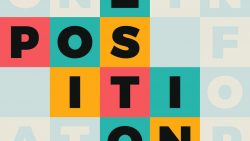introduction
A preposition often connects two things: (1) a noun, adjective or verb that comes before it, and (2) a ‘prepositional object’ – a noun phrase or pronoun
that comes after the preposition.
This is a present for you. He’s looking at her.
I’m really angry with Joe. They live in a small village.
In some structures, we may put the prepositional object at or near the beginning of a clause. In this case, the preposition does not always go with it –
it may stay together with ‘its’ noun, adjective or verb at the end of the clause. This happens especially in four cases:
wh-questions: Who’s the present for?
relative structures: Joe’s the person that I’m angry with. passives: She likes to be looked at.
infinitive structures: The village is pleasant to live in.
wh-questions
When a question word is the object of a preposition, the preposition most often comes at the end of the clause, especially in informal usage.
Who’s the present for? (For whom is the present? is extremely formal.) What are you looking at?
Who did you go with?
Where did she buy it from?
Which flight is the general traveling on?
What kind of films are you interested in?
This also happens in indirect u’/i-quesLions, and in other what-clauses.
Tell me what you’re worried about.
What a lot of trouble I’m in!
Some questions consist simply of question word + preposition.
What with? Who for?
However, this structure is unusual when there is a noun with the question word.
With what money? (NOT What money with?)
relative clauses
When a relative pronoun (see relatives 1: basic information) is the object of a preposition, the preposition also often goes at the end of the clause,
especially in informal usage.
Joe’s the person that I’m angry with. (Less formal than … with whom I am angry.)
This is the house (that) I told you about.
(Less formal than … about which I told you.)
You remember the boy (who) I was going out with?
She’s the only woman (who) I’ve ever really been in love with.
That’s what I’m afraid of.
Because whom is unusual in an informal style, it is very rare in clauses that end with prepositions (see relatives 5: advanced points.3,7).
passives
In passive structures (see passives 1: passive structures and verb forms-420), prepositions go with their verbs.
She likes to be looked at.
I don’t know where he is – his bed hasn’t been slept in.
Carol was operated on last night.
infinitive structures
Infinitive complements (see infinitives 6: after adjectives-285) can have prepositions with them.
The village is pleasant to live in.
She needs other children to play with.
Can you get me a chair to stand on?
I’ve got lots of music to listen to.
Their house isn’t easy to get to.
exceptions
Many common adverbial expressions consist of preposition + noun phrase (e.g. with great patience, in a temper). In these cases, the preposition is
closely connected with the noun, and is kept as near as possible to it; it cannot usually be moved to the end of a clause.
I admired the patience with which she spoke, (NOT … the patience she spoke with.)
During and since are not normally put at the ends of clauses.
During which period did it happen? (NOT Which period did it happen during?)
Since when have you been working for her? (NOT When have you been working for her since?)
formal structures
In a more formal style, a preposition is often put earlier in questions and relative structures, before the question word or relative pronoun.
With whom did she go?
It was the house about which he had told them.
She was the only woman with whom he had ever been in love.
This can also happen in infinitive complements, in a very formal style.
A relative pronoun is used.
She needs other children with whom to play.
It is a boring place in which to live.
Note that after prepositions which and whom can be used, but not normally who and that.
Even in a very formal style, prepositions are not often put at the beginning of questions which have be as the main verb.
Who is it for, madam? (NOT For whom is it?)
And the structures where … to, what… like and what… for have a fixed order.
Where shall I send it to? (but not TO where shall I send it:’)
What does she look like? (BUT NOT hike what-does she look?)
What did you buy that for? (BUT NOT For what did you buy that?) Prepositions cannot be moved away from passive verbs even in a formal style. In my
family, money was never spoken about, (NOT … about money was never -spoken:)
For more information about formal and informal language, see kinds of English 4: formality.
For sentences like It’s got a hole in (it)-, I like cakes with cream on (them), see ellipsis 1: introduction.13.
For more information consult a good dictionary like Langman, Oxford, Merriam Webster, or Collins.



Add Comment